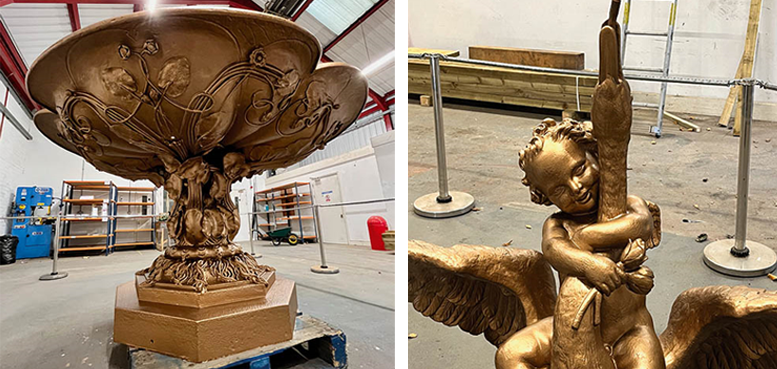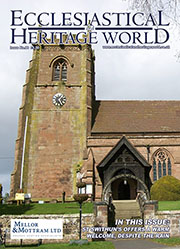Restoration of Darby’s Great Exhibition fountain nears completion
 (L-R) The fountain before conservation; close up of the bowl’s corrosion; the bowl after cleaning; and the finish being applied to the bowl after being primed
(L-R) The fountain before conservation; close up of the bowl’s corrosion; the bowl after cleaning; and the finish being applied to the bowl after being primed
The fountain known as the Swan and Boy is currently displayed outside the Museum of Iron in Coalbrookdale, Shropshire: just in front of Abraham Darby’s original iron furnaces. It was cast by the Coalbrookdale Company in around 1850, originally for the Great Exhibition of 1851 organised by Prince Albert in Kensington, London. The foundry won an award at the Exhibition. Today it is Listed Grade Two by Historic England.
The Coalbrookdale Company was founded by Abraham Darby in 1709, when he took a lease on the Coalbrookdale Furnace. Importantly, Abraham Darby started to use coke as the fuel in the process of making cast iron, replacing charcoal. That allowed for a huge improvement in the process and the company grew rapidly in size in the early 18th century. In 1779 Abraham Darby III cast and erected the first iron bridge over the River Severn at Ironbridge. It was his son Francis Darby who was responsible for a revival of the business after a downturn at the end of the 18th century, with the development of art castings and decorative ironwork.
The Swan and Boy fountain was designed by the Victorian sculptor John Bell (1811-1895) of Great Yarmouth, Norfolk. It was displayed in the north transept of the Crystal Palace building at the Great Exhibition, in front of a huge pair of ornamental gates made by the Coalbrookdale Company. The fountain was bought after the exhibition by the Wolverhampton Corporation in 1853 for the sum of £150 and was erected inside the new General Market Hall. It remained there until 1881. Sometime around the 1930s the fountain was dismantled and put into storage. It was later ‘discovered’ in a potting shed and returned to Coalbrookdale in 1959.
The company restored the fountain at the foundry and erected it on a concrete base very close to the old furnace in 1959 for the opening of the Museum of Iron. At that time the swan and boy figures were gilded, with the fountain bowl and pedestal being painted green. In 1979, when the current Museum of Iron building was opened, the fountain was moved inside to be displayed against a backdrop of the Crystal Palace.
In 1995 it was moved outside to its current location and was subject to a major programme of conservation. A number of parts had corroded significantly, and several water lily leaves applied to the bowl were renewed. The decision was made to finish the fountain in a bronze colour, with the work being undertaken by a local conservator based in Much Wenlock.
It was erected on a new brick plinth with a sunken pond lined with a rubber membrane. An additional nozzle was added to try to improve the water jet coming from the swan’s beak.
In 2012 there was a further period of repair, stabilisation and repainting, when the fountain was cleaned back to bare metal, removing the 1959 paint finishes. An oil-based paint system was applied to the same bronze finish.
By 2021 the fountain was looking a bit tired with some areas of paint finish beginning to break down, especially where they were exposed to sunlight and water, where some minor rust patches were developing. In addition, limescale had accumulated from the presence of water.
There were also problems with the water supply and a leak in the pond lining. Peter Meehan ACR was appointed by the Ironbridge Gorge Museum Trust to prepare a condition report on the fountain, along with recommendations for its conservation treatment. The trust was able to obtain external funding and commissioned the conservation work at the beginning of October 2022.
 The bowl and pedestal, and the swan and the boy after the bronze finish was applied
The bowl and pedestal, and the swan and the boy after the bronze finish was applied
In order to make the conservation works easier to carry out – as it was started in the autumn – the fountain was carefully lifted from its brick plinth and transferred to a workshop space behind the Enginuity Museum at Coalbrookdale, a short distance away. The swan and boy figures were removed from the fountain bowl, partly to make them easier to clean and treat and also to allow for repairs to the fixings which had corroded to excess, being made of mild steel.
That also allowed for works to be carried out to the pond and water supply while it was removed. Apart from the fountain bowl, the paint finish was found to be in a good overall condition, still adhering well to the underlying substrate. It was therefore left being cleaned and lightly abraded to allow for repainting.
The paint on the fountain bowl had completely failed, so it was decided to remove it back to bare metal using hand scrapers and rotary wire brushes equivalent to Swedish Standard ST3. Those surfaces were then brush painted with two coats of an alkyd oil-based zinc phosphate primer – Sherwin-Williams Kem-Kromik 489. The nozzle fitted to the swan’s beak was removed and replaced with a simple copper tube – more in keeping with the original design.
It was agreed that the fountain should retain a bronze finish. The previous bronze appearance had been skilfully created by the conservator. For the repaint it was decided to use an oil-based, bronze paint system instead and Ardenbrite was chosen. That system consists of a special primer, metallic paint containing fine metal particles and a clear protective lacquer to help prevent UV degradation. Each of the paint layers was brush applied and left to fully dry. A mix of old penny bronze and a lighter bronze (no 27) were applied to give the fountain a greater depth. The swan and boy were refitted to the fountain bowl with new threaded fixings before the final lacquer coat was applied by spray.
The fountain is now awaiting completion of the work to the brick plinth, pond and water supply, before being returned to public display again in the summer. The conservation work will ensure the fountain continues to be preserved and enjoyed by visitors for many years to come.
For further information visit www.hm-cc.uk
















